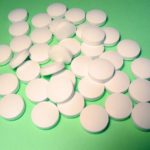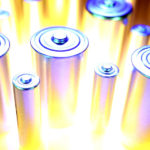生物可降解材料
陈建香
扬州大学化学化工学院
关键词:生物可降解,聚乳酸,塑料
近些年不可降解塑料的大量使用带来了严峻的环境污染问题,开发无毒环保的材料迫在眉睫,日益枯竭的石油资源也促使人们寻找新一代的不依赖于石油资源的新材料,生物可降解材料因此受到越来越广泛的关注。
生物可降解材料是指在自然环境中能由微生物进行分解成水和二氧化碳再回归到自然的一类材料。生物可降解材料按其特性可分为:完全生物可降解高分子材料和生物破坏性高分子材料。按照来源,生物可降解材料可以分为:天然高分子材料、微生物合成的生物可降解材料和化学合成的生物可降解材料。天然高分子材料主要有:纤维素、半纤维素、淀粉、甲壳素、木质素、果胶、壳聚糖等[1-3];微生物合成的生物可降解材料主要有:聚羟基丁酸酯、聚羟基戊酸酯等[4-6];化学合成的生物可降解材料主要有:聚乳酸、聚已内酯、聚丁二酸丁二醇酯、聚碳酸亚丙酯等[7-11]。
化学合成的生物可降解高分子材料由于具有可塑性、可加工性以及生产成本较低等优点而日益受到了重视。其中,聚乳酸(PLA)是结构最简单、最典型的生物可降解线性脂肪族聚酯。PLA是以天然有机酸乳酸经脱水聚合成,其结构通式为:
![]() PLA中的手性碳原子使其具有多种立体异构,包括内/外消旋聚乳酸(PDLLA)、左旋聚乳酸(PLLA)和右旋聚乳酸(PDLA)。其中,PDLLA为非结晶材料,而PLLA和PDLA则具有良好的结晶性能。
PLA中的手性碳原子使其具有多种立体异构,包括内/外消旋聚乳酸(PDLLA)、左旋聚乳酸(PLLA)和右旋聚乳酸(PDLA)。其中,PDLLA为非结晶材料,而PLLA和PDLA则具有良好的结晶性能。
聚乳酸具有优异的抗拉强度、良好的透明性、抗溶剂性和加工成型性等优点。因此已逐渐地应用于农用薄膜、包装袋、包装盒和纺织品等日常生活领域。此外,由于具有良好的生物相容性和组织可吸收性,PLA 已成功应用于医用手术缝合线、骨支撑材料和药物缓释载体等生物医学领域 [12-13]。

图一:聚乳酸水杯
参考文献:
[1] Edgar, K. J.; Buchanan, C. M,; Debenham, J. S.; Rundquist, P. A.; Seiler, B. D.; Shelton, M. C.; Tindall, D. Advances in cellulose ester performance and application. Prog. Polym. Sci. 2001, 26: 1605-1688.
[2] Rinaudo, M. Chitin and chitosan: properties and applications. Prog. Polym. Sci. 2006, 31: 603-632.
[3] Kumar, R.; Majeti, N. V. A review of chitin and chitosan applications. React. Funct. Polym. 2000, 46: 1-27.
[4] Ohkoshi, I.; Abe, H.; Doi, Y. Miscibility and solid-state structures for blends of poly[(S)-lactide] with atactic poly[(R,S)-3-hydroxybutyrate]. Polymer 2000, 41: 5985-5992.
[5] Koyama, N,; Doi, Y. Miscibility of binary blends of poly[(R)-3-hydroxybutyric acid] and poly[(S)-lactic acid]. Polymer 1997, 38: 1589-1593.
[6] Kikkawa, Y.; Suzuki, T.; Tsuge, T.; Kanesato, M.; Doi, Y.; Abe, H. Phase structure and enzymatic degradation of poly(L-lactide)/atactic poly(3-hydroxybutyrate) blends: an atomic force microscopy study. Biomacromolecules 2006, 7: 1921-1928.
[7] Kumagai, Y.; Doi, Y. Enzymatic degradation and morphologies of binary blends of microbial poly(3-hydroxy butyrate) with poly( ε -caprolactone), poly(1,4-butylene adipate and poly(vinyl acetate). Polym. Degrad. Stab. 1992, 36: 241-248.
[8] Calil, M. R.; Gaboardi, F.; Guedes, C. G. F.; Rosa, D. S. Comparison of the biodegradation of poly( ε -caprolactone), cellulose acetate and their blends by the sturm test and selected cultured fungi. Polym. Test. 2006, 25: 597-604.
[9] Gupta, B.; Revagade, N.; Hilborn, J. Poly(lactic acid) fiber: an overview. Prog. Polym. Sci. 2007, 32: 455-482.
[10] Okada, M. Chemical syntheses of biodegradable polymers. Prog. Polym. Sci. 2002, 27:87-133.
[11] Yu, L.; Dean, K.; Li, L. Polymer blends and composites from renewable resources. Prog. Polym. Sci. 2006, 31: 576-602.
[12] Ise, D. L.; Fellmann, T. D.; Sanderson, J. E.; Wentworth, R. L. Lactic/glycolic acid polymers,in: drug carriers in biology and medicine. Academic Press: London, New York, 1979.
[13] Ajioka M, Enomoto K, Suzuki K, Yamaguchi A. Basic properties of polylactic acid produced by the direct condensation polymerization of lactic acid. Bull. Chem. Soc. Jpn.1995, 68: 2125-2131.
*本文仅代表作者个人观点,不代表本网站观点;如其他媒体、网站或个人从本网站转载使用,需注明文章来源,并自负版权等法律责任;作者如不希望被转载或者联系转载稿费等事宜,请与我们联系。
Post Reviews:
No reviews yet...







